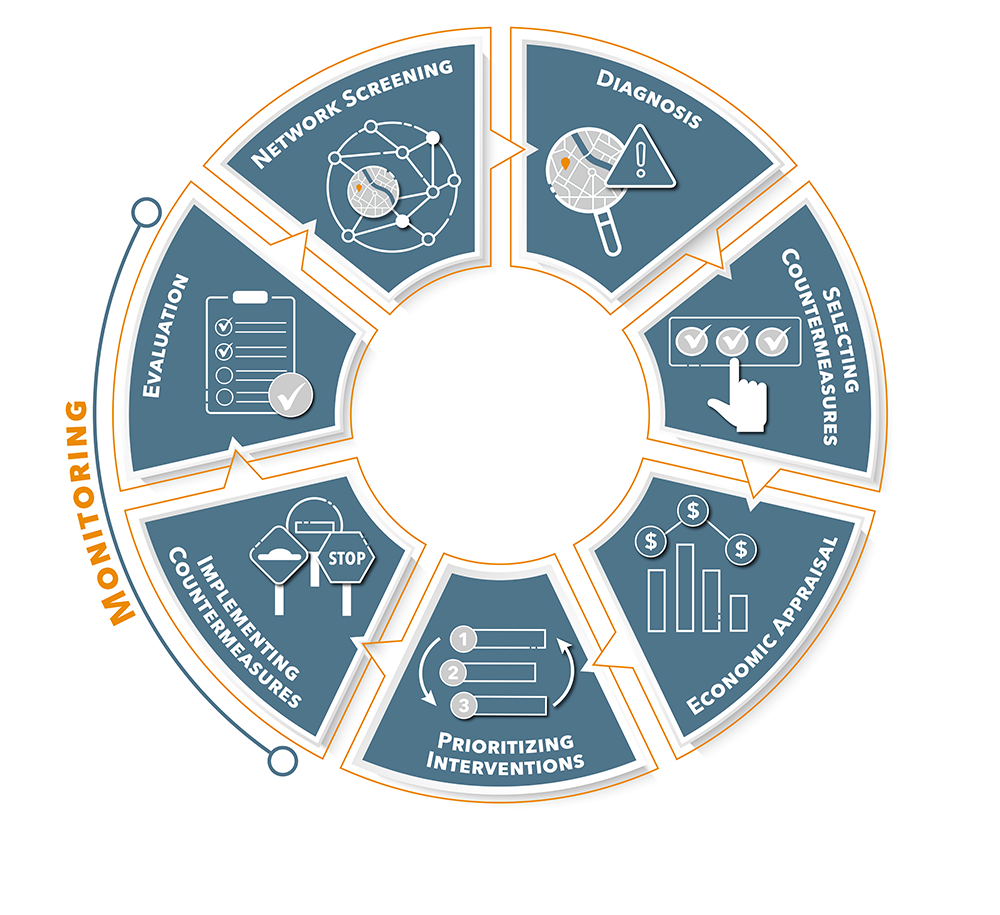Monitoring & evaluation (M&E) are key components of successful road safety management.
Monitoring involves collecting data to understand a program’s progress towards a specific goal or objective. For example, if a program is launched to reduce vehicle speeds in residential areas with the aim of reducing collisions resulting in injuries or fatalities, stakeholders such as transportation agencies, law enforcement, public health agencies, and communities may want routine data to understand the progress achieved or lack thereof. These data could include how many road signs have been reduced to 30 kilometres per hour (km/h), hours of police enforcement time dedicated to speed management, number of violations issued by police, or media campaign reach (e.g., frequency, number of people). With these data, stakeholders are empowered with up-to-date information on the program’s progress and can identify any needed adjustments.
Evaluation involves assessing an intervention’s impact. For example, if the same campaign is launched to reduce vehicle speeds in residential areas, a city should assess if the campaign has reduced vehicle speeds, injuries and deaths. To do so, data on speeds and collisions before and after the campaign are compared. The evaluation findings can and should be shared with stakeholders to inform decision-making. Examples of decision-making could include if funds should be allocated differently, or if a program should be changed, improved, or implemented more widely.
Effective road safety efforts in a community should be based on objective data, rather than subjective opinions or experiences. When programs and policies are implemented based on subjective experiences, they may not be the best use of resources.
M&E promotes effective implementation and evidence-based decision-making, ensuring optimal use of resources for a community. This may include interventions which are the least costly, most cost-effective, or most equitable by reaching those disproportionately affected by road safety issues. Furthermore, M&E can increase accountability among stakeholders. Transparent reporting of M&E ensures stakeholders are informed about the program’s progress and outcomes, and holds agencies responsible for their decisions and investments in road safety.
Lastly, there are notable research gaps in understanding what works in road safety, particularly in certain areas (e.g., low- and middle-income countries) or for specific road user types (e.g., active transport users). This lack of reliable knowledge negatively affects efforts to prevent injuries and deaths on the roads. Assure conducting evaluations and sharing results can benefit other communities.
A road safety management process typically involves assessing a risk, selecting countermeasures, using economic appraisal to prioritize potential countermeasures, and implementing the selected measures, as shown in Figure 1.
As discussed in previous A2Z engineering modules on Network Screening and Diagnosis & Countermeasures, a comprehensive and system-level assessment of risk is a critical first step in understanding the issues and priorities for a community. Once sites and safety concerns are identified, a list of appropriate countermeasures can be developed to target the contributing factors. From this, an intervention or set of interventions can be selected and implemented.
It is critically important to set up an M&E system at the outset of an intervention, rather than once the intervention is implemented to ensure appropriate and necessary data is collected. This system could involve collecting data about the outcome (e.g., crashes), the exposure (e.g., traffic volume), site characteristics, and treatment details and dates.
Figure 1: Road safety management process.

There are a variety of national, Canadian, and US tools available to guide decision-making with respect to countermeasures and their implementation.
This manual introduces various aspects of road safety, including planning and designing, identifying issues and risks, selecting interventions, and monitoring and evaluation. World Road Association, https://roadsafety.piarc.org/. Available at no cost although an account must be created to download a PDF.
The ABD-ASEAN Regional Train the Trainer Road Safety Capacity Building Program on Road Safety Management This webinar provides an overview into how M&E fits into a road safety management program. https://events.development.asia/materials/20140627/road-safety-management-8-monitoring-and-evaluation. Available at no cost.
The Highway Safety Manual This comprehensive resource provides knowledge and resources aimed at promoting evidence-based decision-making in road safety. Chapter 9 on Safety Effectiveness Evaluation provides guidance on performing evaluations of road safety countermeasures. American Association of State Highway and Transportation Officials, https://www.fpp.uni-lj.si/mma/HSM.pdf/2019060611143076/?m=1559812470. Available at a cost.







